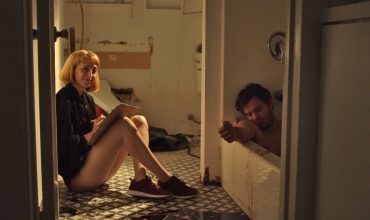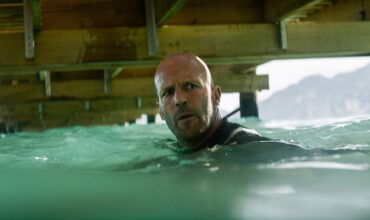Hatching is a festival award-winning Finnish horror film directed by a woman (Hanna Bergholm) who’d never made a full-length feature before. Appropriately titled Egō in the festival’s host country and Pahanhautoja (which the ever trustworthy Google Translate claims to mean ‘evil graves’) in its native tongue, the film contains an outer membrane of gooey unpleasantness and a delicious yolk full of family secrets and hereditary trauma. Hatching explores complex themes about female relationships (between mothers and daughters, peers and competitors and most notably, with oneself) and it’s about a young girl who unintentionally hatches a monstrous baby bird to do her dark bidding. Watching the trailer, I saw a little more than I would’ve liked to see of the creature, but what it failed to spoil is what lies beneath the fragile shell of a child pushed too far.
Tinja (Siiri Solalinna) is a 12-year-old gymnast through which her lifestyle-blogging mother (who remains unnamed throughout the film) lives vicariously. Her life revolves around practising for her upcoming competition and being filmed doing so for Mother’s benefit. She has a timid (unnamed) father and annoying younger brother Matias – neither of whom Mother seems much to value, apart from their use as props for her cringey blog, Lovely Everyday Life. Our first introduction to Tinja is from the perspective of Mother’s pedicured right hand as it witchily reaches out to her, while the left holds her phone and documents the impending tickling session. Thankfully, nature’s tolerance for bullshit is as low as ours.
One morning, while filming some nonsense in their right-out-of-the-catalogue living room, a crow flies in through a window and decides to wreak havoc. Tinja gently throws a towel over the bird to subdue it and as she cradles it to her chest, Mother instructs her to “bring it here”. Without a second thought or furrowed brow, she breaks the bird’s neck and tells Tinja to throw it in the trash. Tinja reluctantly obliges, but wakes later that night to the sound of cawing. Identifying the source of the cries to be the woods beyond their house, Tinja finds that the crow is still alive and in terrible pain. In a violent act of mercy carried out with the assistance of a nearby rock, she puts the bird out of its misery, realising shortly after that a lone egg sits oddly on the ground, now down one mother. She carries the egg (with her guilt) back to her bedroom, where she carefully incubates it inside the chest of a large, pink teddy bear.
We’re often told to leave eggs where we find them, lest the natural mother comes back and we displace her, forcing the hatchlings to imprint on us instead. But Tinja’s mother lacks the maternal instinct required to pass even the most basic of egg-related primary school experiments, let alone raise her own children properly, so it’s unlikely she ever passed this knowledge on to Tinja. Perhaps, due to her own inadequate parentage, Tinja puts everything she has into caring for this egg and to her surprise, its cup runneth over. Pouring her inner thoughts and repressed feelings into the only being she feels comfortable talking to, the egg grows to an alarming size until one night, a clawed hand pierces through its shell and pulls its monstrous self into her pristinely decorated bedroom.
Like many films before it, Hatching takes the monster-as-metaphor route in depicting a dark or difficult period in its heroine’s life. Bergholm cites clear influences such as Jennifer Kent’s The Babadook and Tomas Alfredson’s Let The Right One In and there are definite thematic parallels (especially with the former) that can be drawn. Hints at repressed childhood trauma, inherited insecurities, the horrors of puberty and even the possibility of an eating disorder in our young protagonist make the creature’s sudden existence seem inevitable.
The use of movement in inadvertently summoning something wicked (the film opens by tracking Tinja’s unfurling spine as she stretches) is likely a reference to the dance spells in Luca Guadagnino’s Suspiria, whose original text is further paid reverence in a nighttime sequence in which the creature’s talons caress Mother’s curious thigh scar as she slumbers alone in her exceedingly extra four-poster bed. While it can be said that Bergholm is perhaps overly liberal in her use of homage, such similarities do offer crucial insights into the central relationship of the film.

“Can I offer you a nice egg in this trying time?”
If Lamb explored the sins of false mothers, Hatching flips the narrative and focuses on a natural mother who, for reasons perhaps related to her own implied dysfunctional childhood, is unfit to sit on her own egg. Her daughter, inversely, provides a level of dedication and nurturing to her hatchling (blood, sweat and tears, if you will) that it starts to evolve itself into her image. But Tinja seems not of her mother, like she too was found one day and stolen, to be raised by an imposter with another agenda.
It’s unclear whether Mother has an actual online following, ravenous for her sickly sweet content, or whether she’s broadcasting herself and her family (unpaid) to the void, financially supported by her cuckold husband and whatever it is he does for a living. What she lacks in real life relationships she projects onto Tinja, initiating wildly inappropriate conversations about her affair with a handyman, and how it’s the first time in her life she’s ever truly loved someone. Mother keeps the rest of the world at the distance of a selfie stick and her daughter under her taloned thumb, which gets noticeably more manky as the film progresses. Comparisons to Coraline cannot be ignored but in this unfortunate scenario, Tinja has lived with her Other Mother since birth.
There are instances later in the film of Mother repeating this cycle on the infant daughter of her lover – a widower who, for a fleeting period, provides Tinja with genuine care and age-appropriate conversation. But as Tinja disappoints Mother with her lacklustre performance on the bars, she turns to Alli (named after eerie folk song ‘Alli’s Child’), her hatchling and the physical manifestation of everything she doesn’t wish her mother to see. The more pressure Mother puts on Tinja, the more Tinja ‘feeds’ Alli, with dire consequences for those around her.
Bringing Tinja’s twisted and vulnerable psyche to life in the form of Alli is Gustav Hoegen (of Star Wars fame), creating a bird-human hybrid through remote controlled puppetry. There’s a Jim Henson quality to Alli that reminded me why it took two decades to finally get through The Dark Crystal, but a tiny dash of cuteness separates her from the Skeksis. As Alli moults gradually to form a creation in her mother’s image, parts of her are left behind. One scene, in which Tinja discovers a sickeningly sticky discarded beak in her wardrobe, is exactly the kind of body horror I love. I do feel, however, that these moments would have more of an impact if we didn’t see Alli in the flesh as often as we do.
This problem likely stems from an uncertainty in how to tell the story. Bergholm says she never really intended to make a horror film and that the focus was always supposed to be on the central relationship and the horror that comes naturally from its dysfunction. And depending on what you’re looking for in a fantasy drama with horror elements, you may be disappointed by the scarcity of scares and lack of exploration into what Alli actually is on a figurative level. It’s interesting to note that my husband found the family drama less interesting and yearned for more of the monster, while I could’ve done with fewer explicitly creature-based scenes. I found the dynamic between Tinja and her mother fascinating and truly disturbing – I just wanted more.
Perhaps this is further testament to the performances of the leads, who carry this film squarely on their shoulders. Siiri Solalinna is wonderful as Tinja – to me, a spiritual sister to the subdued ballerina daughter in Maury and Bustillo’s vampiric spooky house tale, Livid. Where Anna’s mouth was sewn shut by her mother, Tinja is silenced in other, more self-imposed ways. The shedding of her hatchling’s beak is surely representative of a refusal to stay muzzled and develop a voice, while Mother’s unravelling (Sophia Heikkilä delivers one of the best steering wheel tantrums put to screen) is glorious to watch.
Hatching uses a decidedly female voice in telling a story that will probably be most disturbing to women (particularly those whose palms were perpetually callused from competitive sports in their youth) and I think it makes for a pretty tasty first omelette from a promising director. I can’t imagine that the row of 40-something boys behind me at Monster Fest got much out of it (especially considering the surprise over the subtitles and loud declaration of “is this a foreign film?”) but I left with thoughts, questions and feathers floating around my head for the few days that followed. While Hatching may not quite deliver on terror, its depiction of the horrifying nature of one mother’s ‘love’ (like which there is no other) will peck at your innards long after the credits roll. 7.5/10
Hatching comes out of incubation May 26.


